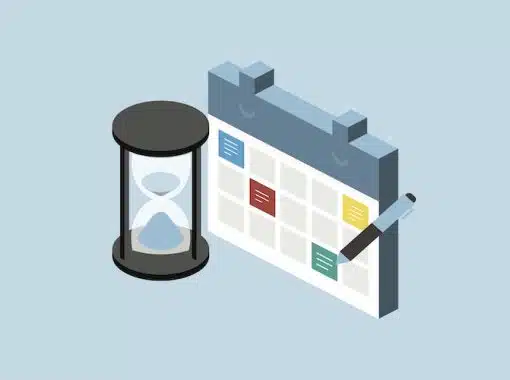
In the modern work environment, if you don’t control your schedule, it can take control of you. So how is it possible to make room for emails, meetings, team chats, and other necessary evils of the workday and still have heads-down time to focus on the tasks you really want to do that will add value to your business?
For many people that maintain high levels of productivity, like Elon Musk and Bill Gates, the secret to their success is a planning method called “time blocking.” Let’s look at what this scheduling process is, some of its benefits, and how you can start using it.
Table of Contents
What Is Time Blocking?
Time blocking is a productivity technique that involves dividing your day into blocks of time and assigning specific tasks or activities to each block. For example, you might divide your day into blocks for work tasks, exercise, meals, and personal time.
Instead of an open-ended to-do list full of tasks you will do when you have the time, you begin each workday with a detailed itinerary. Time blocking will not only tell you what you have to do but also a time to get it done.
To-do lists may work for some people, but for many, it allows them to neglect high-priority tasks and spend too much time on less-important tasks. If you have this problem, time blocking may help you out.
How and Why Does Time Blocking Work?
One reason time blocking is so effective is that it requires a weekly review. Every week, you look over the tasks that require your attention in the upcoming week and prioritize them. Once you do that, you fit them into appropriate times in your week.
Another reason time blocking works so well is that it is based on single-tasking, not multitasking. By blocking out your days, you know exactly what you should work on in each hour of the day and can accomplish deep work instead of spending time figuring out what to do next. As a result, time blocking has been shown to improve productivity by up to 80%.
Time blocking also keeps you from putting off time-sucking tasks like checking and answering emails when you can batch them together and get them over with.
What are the Benefits of Time Blocking?
Once you start using time blocking, you will begin to notice some of the benefits that make it such a popular method of scheduling tasks, including:
- It helps you focus: When you have a specific task or activity to work on during a certain time block, you can focus on that task without distractions.
- It helps you plan and prioritize: By breaking your day into blocks of time, you can better plan and prioritize your tasks and activities. This can help you ensure you are working on the most important tasks first and that you have enough time to complete everything you need to do.
- It helps you avoid multitasking: Multitasking can be counterproductive because it can decrease your focus and increase the time it takes to complete tasks. By time blocking, you can avoid this and focus on one task at a time, which can help you work more efficiently.
- It helps you manage your energy levels: Time blocking can also help you manage your energy levels by allowing you to take breaks between tasks and activities. This can help you stay energized and motivated throughout the day.
- It helps you determine just how much time a task takes: You may not block out your time accurately in the beginning, but with practice, you will build a much more efficient and accurate schedule.
- It stops procrastination: When you set a time for a task, it won’t get ignored in a to-do list.
How to Use Time Blocking
Now that you know why time blocking works and some benefits it brings, let’s look at what you need to do to make it work for you.
- Create a to-do list: At the beginning of the week, make a list of all the tasks you do daily and weekly. This list should include both personal and work tasks. Order the list by priority so you know which to schedule first once you get to that step.
- Estimate how long each task will take: If a task takes longer than one work session, it helps to break it down into smaller tasks so that you can spread them throughout the day or week. Smaller tasks like reviewing the day’s emails and work chats can be batched together in a single block of work.
- Start with the bookend tasks: Time blocking is not meant to make you work from the time you get up until you go to bed. Start by adding blocks in your calendar at the beginning of your day for your morning rituals and at the end to wind down.
- Schedule time for your to-do list tasks: Start with the high-priority tasks and work down the list, blocking out time on your calendar for each.
- Follow your schedule: The first week may not be perfect, but as you get used to the process and become better at estimating your tasks, it will get much smoother.
Time blocking is only one of many methods of managing time. But it’s popular because it has worked for so many people. It can do the same for you and give you greater control of your time and the peace of mind that everything that needs to get done has been accounted for.












